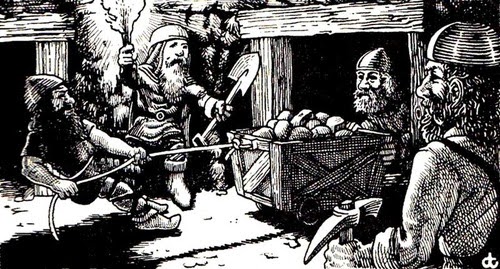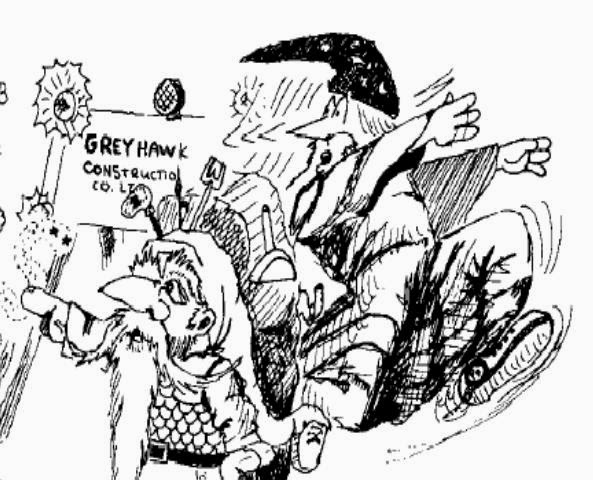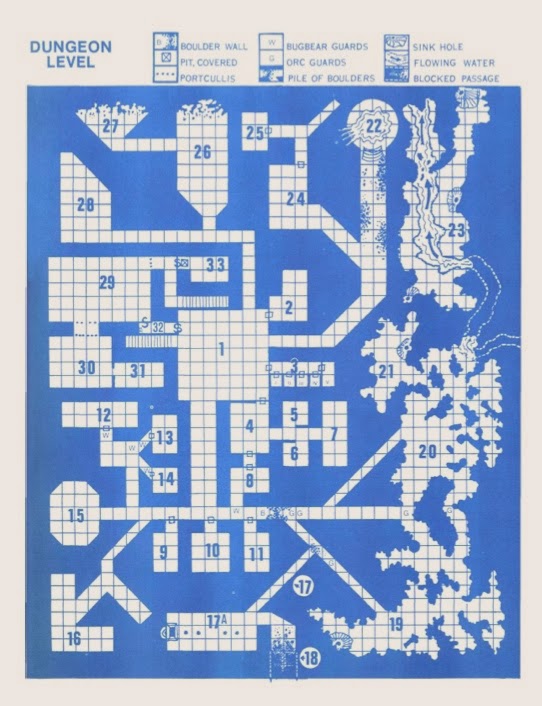There are a number of game mechanics built into the AD&D rules (and other versions, but I’ll be using AD&D 1st edition as my primary example here) that directly support the idea that megadungeon play – as exemplified in campaigns such as Castle Greyhawk, Maure Castle, and Castle Blackmoor – was the norm for which the game rules were originally designed. These feature huge dungeon environments that are “living” in the sense that the environment is itself changing, even physically, as more levels and side-levels are being added, features and creatures change over time in reaction to the players’ actions and the internal logic of the place, and as a rule it is never possible to “finish” the adventure. Several game mechanics point to this as the original intention of how the game was to be played.
The first is the ability to “detect grade or slope in passage, upwards or downwards” (dwarves 75%, gnomes 80%). This is useful in situations where there are long corridors that have a nearly-imperceptible slope. These are often found in large dungeons in order to conceal a transition from one dungeon level to another. Incidentally, the existence of such sloping dungeon corridors also implies the existence of non-sloping dungeon corridors that are just as long, in order to provide “cover” for the sloping ones. Without such long corridors, every time the PCs encountered a long hallway, their guard would be up and they would suspect they were being sloped down or up to another level.
The second is the dwarves’ ability to “detect new construction or passage/tunnel” (75%). This is an ability that only makes sense in a context where there is new construction to be found, and the fact that it is new has some significance. As has been discussed many times in many places, one of the features of a megadungeon is that it is never “finished”, either from the players’ perspective or the DM’s. There are always new levels being created and thus constructed (see for instance the Greyhawk Construction Company), and when the players come upon a corridor opening where none had been before, it’s their cue that a new area has been added to the dungeon, and is thus worthy of exploration.
The third is the ability to “determine approximate depth underground” (dwarves 50%, gnomes 60%). This comes into play in dungeons where there is a possibility that one has gone from one level to another without realizing it. That can come from a variety of different reasons – the aforementioned sloping corridors, as well as undetectable elevator rooms, teleportation effects, slides, and pits – but is only really significant in an environment where there are multiple levels of the dungeon, and where the level that you’re on actually matters. As a rule, in a megadungeon (or other old-school type dungeon, for that matter) deeper=more dangerous. When the difference between level one and level five is the difference between an encounter with an orc and an encounter with a troll, it matters. Otherwise, you’re just lost, and being lost on level five is no worse than being lost on level one.
The fourth is the gnomes’ ability to determine direction of travel underground (50%). This is important in dungeons where features are set up specifically to interfere with accurate mapping, such as teleporters, spinning rooms, mazes, natural twisty caverns, etc. In even a large conventional dungeon such as Hall of the Fire Giant King, there are no real opportunities to get lost in a directional sense.
Look, too, to the back of the AD&D Players Handbook, in the section labeled “Successful Adventures” (pp. 107-109):
“…talk to the better adventurers so that you will be able to set an objective for the adventure. Whether the purpose is so simple as to discover a flight of stairs to the next lowest unexplored level or so difficult a to find and destroy an altar to an alien god, some firm objective should be established and then adhered to as strongly as possible.
“If transported or otherwise lost, begin mapping on a fresh sheet of paper, and check for familiar or similar places as you go along. Never become despondent; fight until the very end.
“Avoid unnecessary encounters. … Your party has an objective, and wandering monsters are something that stand between them and it. The easiest way to overcome such difficulties is to avoid the interposing or trailing creature if at all possible. Wandering monsters typically weaken the party through use of equipment and spells against them, and they also weaken the group by inflicting damage. … In the same vein, shun encounters with creatures found to be dwelling permanently in the dungeon (as far as you can tell, that is) unless such creatures are part of the set objective or the monster stands between the group and the goal it has set out to gain. Do not be sidetracked.”
“If the party becomes lost, the objective must immediately be changed to discovery of a way out. If the group becomes low on vital equipment or spells, it should turn back. The same is true if wounds and dead members have seriously weakened the group’s strength. The old statement about running away to fight another day holds true in the game.”
As you can see, this advice is much more pertinent to a large-scale dungeon environment, with multiple levels, multiple possible objectives (rather than a single “plot” to be followed”), and multiple possible distractions placed there by the DM to lure the players away from their goal with shiny trinkets and dangers.
This is not, of course, to say that other ways of playing are wrong. To be sure, the original rules cover other adventure locales such as wilderness and cities as well, and the only examples that we as players were given in the early days were converted tournament modules that were not suited for the sort of play described here. But the earliest style of play – the massive megadungeon complex – is certainly in the game’s DNA, and shines through in some of the implicit assumptions that made it into the rules.













If anything, reference to a monolithic "underworld", with tables defining which monsters are found on particular levels supports your point.
I've always found most of the primary abilities of unusual swords to be very "telling" as regards the 'dungeon-centricness' of early play (especially considering the early origins of the unusual sword tables)